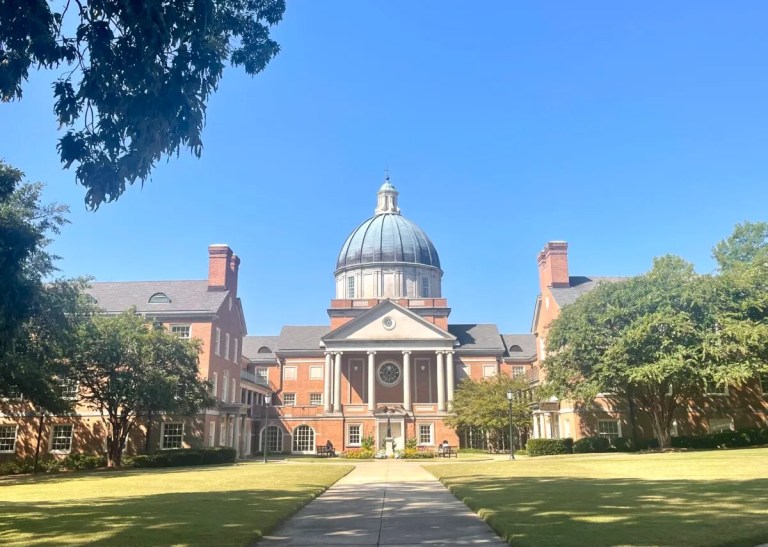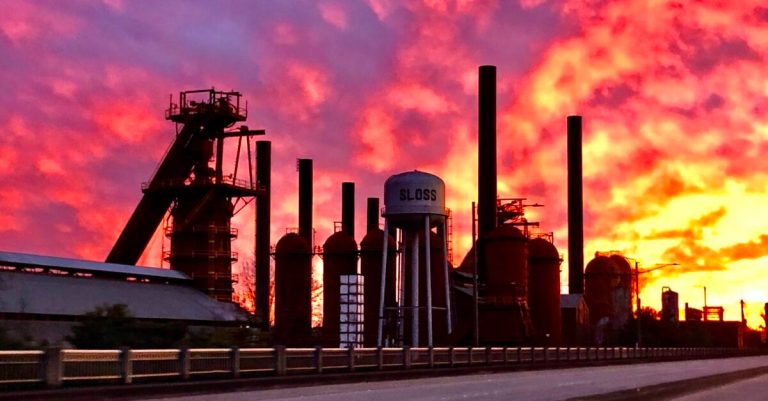Red Mountain Park was once a sea of stumps? Explore 200 years of landscape changes in Alabama
Reading time: 12 minutes
Sponsored

When I was in the 4th grade, I took my first Alabama history class. Without fail, each day, the teacher outlined Alabama on the chalkboard–the rectangular box with the “high heels” that is Baldwin and Mobile counties. At the end of each class, she would wipe away that outline of the state.
That vivid memory represents the changes Alabama’s natural landscapes have experienced. For over 200 years, we have been continuously wiping away and redrawing the scene, changing the map over time.
10 Generations of Alabamians
Ed Bridges, Alabama’s longtime state archivist and author of Alabama, The Making of an American State, described our state’s knowledge about its changing landscapes best:
“Because the changes in Alabama’s landscapes have taken place over such a long period of time, one person’s half of a lifetime hardly sees more than marginal changes. We lack the historical perspective to see the totality of changes that have taken place across ten generations of Alabamians. We all see in our lifetime significant changes but taken together over 200 years, they have been huge. We need to look at a broader timescale to appreciate the impact humans have made on the environment of the state.”
Remembering 1819

In our first installment about Alabama’s natural landscapes, we examined what the state looked like in 1819, the year it was accepted into the Union. Surprisingly, we discovered that much of our land was covered with prairie, wooded grasslands, and canebrake. Today, all three ecosystems are almost completely gone from the state.
In this edition, we again call upon our “landscape detectives” naturalist Bill Finch and Birmingham-Southern professor and ecologist Scot Duncan, author of Southern Wonder, Alabama’s Surprising Biodiversity, to take our readers on a “10 generation” journey of changing landscapes.


We will explore how we depleted the soils in the Black Belt, overharvested our forests and wildlife, re-engineered our rivers, turning free flowing waters into lakes and lost forever over 90 species, primarily mussels and snails.
And, despite all these changes over the past 200 years, Alabama remains one of the most biodiverse states in the nation.
Alabama’s Black Belt, the Richest Soil in the World
During the forty years after Alabama became a state, residents rapidly converted the state’s canebrake and prairie into farmland.
“The Black Belt, where the cane grew and where there was prairie, became famous,” said Finch. “Newspapers all across the world were writing about how rich Alabama’s soils were. It was like selling vacationland in Florida.”
Farming was so concentrated and profitable that for a short time before the Civil War, three to four counties in the Black Belt were in the top ten wealthiest places in North America.
“Huge investments were made into the land – and it was to grow cotton,” added Finch. “Back then, you had to import your fertilizer from South America – guano [bird excrement] from the South American rookeries. There wasn’t a good source of fertilizer so they needed that rich black soil to make it work. By the time of the Civil War, the rich soil was gone – it was like it had been mined. All of the nutrients were mined… depleted in a few years.”
That was Alabama’s first era of exploitation of our landscape. Within four decades, we lost the great Black Belt prairie and canebrake, a landscape that stretched across central Alabama from Macon to Montgomery to Tuscaloosa and the Tennessee Valley.
160 years later, we are only now discovering what we lost, but fortunately, groups like the Southeast Grasslands Initiative is dedicated to bringing back these lost ecosystems.
Railroads and a Sea of Stumps

After the Civil War, the second era of exploitation came from railroads. Before the war, nearly all transportation of goods and services was carried on the river.
That changed with the railroads.
“Railroads made a huge difference to exploit timber,” according to Finch. “The great timber cut started in 1870 and ended around 1920. Every swamp, every forest, every stick of timber was exploited.”
In Birmingham, initially, railroads helped fuel the mining industry. For example, the landscape of Red Mountain Park was stripped clear, when the mining operations used wood from the local forests to power their trains.

Mining on the property that is now Red Mountain Park. Photo courtesy of Red Mountain Park
Along with industrialization, longleaf and shortleaf pine forests were cut down, and converted into agricultural lands and subsequently loblolly pine plantations.
They called the landscape back then the “the sea of stumps.”
Today, those seas of stumps are Red Mountain Park and Ruffner Mountain.

Over harvesting Our Forests, Wildlife and Fish
The first century of Alabama’s statehood is described as an age of overharvesting by Scot Duncan.
“The longleaf woodlands were cleared out,” he said. “They also overharvested shad, sturgeon, deer, and turkey. Only some were killed for sustenance. Most were harvested as marketable commodities. As the decades passed, our tools for harvesting improved. Nets got bigger, saws got faster, guns were more deadly. The more timber and wild game we fed the markets, the greater the demand and the harvesting pressure. With no regulations in place, and habitat loss from deforestation and river alteration, targeted wildlife species couldn’t handle the pressure, and their populations collapsed. The Alabama landscape grew increasingly empty.”

Some critters have rebounded, some have not. Deer and turkey are now plentiful thanks to sustained conservation efforts, and we even brought back the bald eagle. Unfortunately, many fish such as the Alabama Sturgeon are on the cusp of extinction.
Artificial Fertilizer Makes Farming Possible Everywhere
By the 1870s & 1880s, with most of the fertile topsoil gone, you couldn’t even put a plow in the ground in some places. That all changed in the 1890s to 1950s when artificial fertilizer was introduced into the landscape.
Alabamians were able to farm in places that were previously difficult, with soils not rich enough to grow crops. Suddenly you had this artificial nitrogen in areas such as Baldwin County and Sand Mountain that were now viable for farming.
Re-engineering Our Rivers from Free-flowing streams to Dams and Lakes
Quick, how many natural lakes are there in Alabama? Except for some ponds and oxbow lakes, the answer is one – Lake Jackson on the Alabama and Florida state line.
Since the 1910s when first dams were built on the Tennessee River, the state of Alabama has effectively impounded the major rivers of our state. It was one of the biggest re-engineerings of a river system in the history of the United States.

“We built dams for a variety of reasons – for improving river navigation, flood control and generating electricity,” stated Duncan, who is working on a book to be published on southeastern rivers. “Rivers in Alabama are no longer free flowing. They are step-pool systems under tight management. Unless there’s a flood, we decide when the coast gets freshwater, not the rivers.”

90 Species Lost Forever – Why Mussels and Snails Matter
Over the past 200 years, Alabama has lost over 90 species of animals and plants to extinction, according to Duncan. Impounding our rivers from the 1910s to the 1960s caused a vast majority of extinctions, including aquatic species, mussels and snails and a few fish.

“Most people don’t know about mussels and snails, and those that do often don’t care about them. But what most folks don’t realize is that these critters help keep streams healthy and clean. Snails are out there 24/7/365 grazing algae on the stream bottom like little lawnmowers. In streams where their populations are healthy, the bottom isn’t a carpet of green slime.”
“Their cousins, the mussels, clean the water of floating algae and silt. Each mussel filters about 6-12 gallons of water a day, depending on its size, and a healthy population of mussels can keep a stream running clear.”

“We benefit from this. And we don’t have to pay ‘em a dime.”
“Back in the day our rivers and streams were literally paved with mussels and snails, shell to shell, from one bank to the other. Though mussels and snails took a lot of damage during the first century of our statehood from pollution and, for mussels, overharvest for pearls and shell buttons, it was the dams that were the last nail in the coffin for a lot of species,” Duncan said.

“Dams transform a free flowing river into a static deep water reservoir where most river species cannot live. We’ve gained much from having dams, but we’ve lost many of the good things free flowing rivers could be doing for us, like sending sediment to the coast for land-building and providing passage for migrating fish like sturgeon and shad. All that is lost when you put a wall across a river.”
Pulp Mills and Lost Wetlands Turned Our Forests Upside Down
Both Duncan and Finch recognize other changes that have occurred in Alabama’s natural landscapes since World War II.
In the 60s and 70s, we cleared our river bottoms and wetlands to make way for soybean production.
We turned farmland into tree crops. In about 50 years, Alabama’s landscape went from being agriculture dominated to nearly 70% forested. Our new forestlands, most of which are pines in lines, which in places resemble row crops eventually fed up to a dozen pulp and paper mills by the 1990s.
“We are at a point – what’s left (with our forests), we turned upside down. What was prairies, savanna open area are now thickets of junk trees,” added Finch. “Where the best hardwood forests were they are now loblolly pine plantations. In the Red Hills, where we were once the center of tree biodiversity, 25 species of oaks, 7 species of magnolia and all these species of hickory, it is now tree farms. It’s like we’ve turned the world upside down.”
Alabama’s Sprawling Cities

One last significant change in Alabama’s landscape are our rapidly sprawling cities.
In the early 2000s, the Department of Agriculture released a study on urban sprawl, between 1997 and 2002. According to their figures, approximately 318,300 acres of rural land was developed in Alabama – nearly the equivalent of paving an area the size of Huntsville every year.
Meanwhile, one of the fastest-growing conservation communities today in Alabama are land trusts. Groups such as the Freshwater Land Trust in Birmingham, Land Trust of North Alabama, Alabama Forest Resource Center, The Nature Conservancy and the state’s Forever Wild Program are staving off urban sprawl by protecting forests and landscapes throughout the country via conservation easements and land acquisition
15,000 years of Changing Landscapes
“When people visit Alabama for the first time, they remark – ‘wow it is so green and beautiful!’ And it is. It really is. But Alabama has been worked-over hard these past two centuries, and for those aware of what we’ve lost, it can be depressing,” reflects Duncan.

“But consider this – the Alabama landscape has been changing for the past 15,000 years as a result of human management. This is just the latest phase. Fortunately, the state still retains exceptional beauty. We have a tremendous diversity of rivers and our hilly and mountainous regions are lush with regrown forest. Because so much nature has survived, we have more species here than most states in the Union,” said Duncan.
As Finch put it, we have a lot more to work with than most places. What remains is miraculous. Now, the challenge is to get to work on it.
Up next… What will Alabama’s landscape look like in 2119 and who will be shaping it?
Sponsored by:


 13543 views
13543 views

